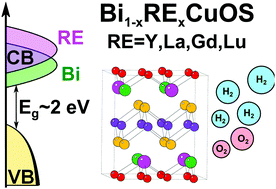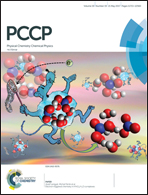Ab initio assessment of Bi1−xRExCuOS (RE = La, Gd, Y, Lu) solid solutions as a semiconductor for photochemical water splitting†
Abstract
The investigation of the BiCuOCh (Ch = S, Se and Te) semiconductor family for thermoelectric or photovoltaic materials is a topic of increasing research interest. These materials can also be considered for photochemical water splitting if one representative having a bandgap, Eg, at around 2 eV can be developed. With this aim, we simulated the solid solutions Bi1−xRExCuOS (RE = Y, La, Gd and Lu) from pure BiCuOS (Eg ∼ 1.1 eV) to pure RECuOS compositions (Eg ∼ 2.9 eV) by DFT calculations based on the HSE06 range-separated hybrid functional with the inclusion of spin–orbit coupling. Starting from the thermodynamic stability of the solid solution, several properties were computed for each system including bandgaps, dielectric constants, effective masses and exciton binding energies. We discussed the variation of these properties based on the relative organization of Bi and RE atoms in their common sublattice to offer a physical understanding of the influence of the RE doping of BiCuOS. Some compositions were found to give appropriate properties for water splitting applications. Furthermore, we found that at low RE fractions the transport properties of BiCuOS are improved that can find applications beyond water splitting.



 Please wait while we load your content...
Please wait while we load your content...